Earlier this week, we visited Project Guns, a tanmall manufacturer in Florida and the home of an interesting project to recreate the Communist Bloc RPD light machine gun. The RPD is the 7.62 x 39 mm squad automatic weapon used by Soviet, satellite and “fraternal socialist” armies and “national liberation movements” from the 1950s through the 1970s. It’s a gas-operated, belt-fed truly light machine gun that evolved from the ancient pan-fed DP through the DPM and DP-46 from Degtyaryev; the RPD, Ruchnoi Pulemyot Degtyaryeva, was, in keeping with its intermediate cartridge, smaller, lighter, and handier.
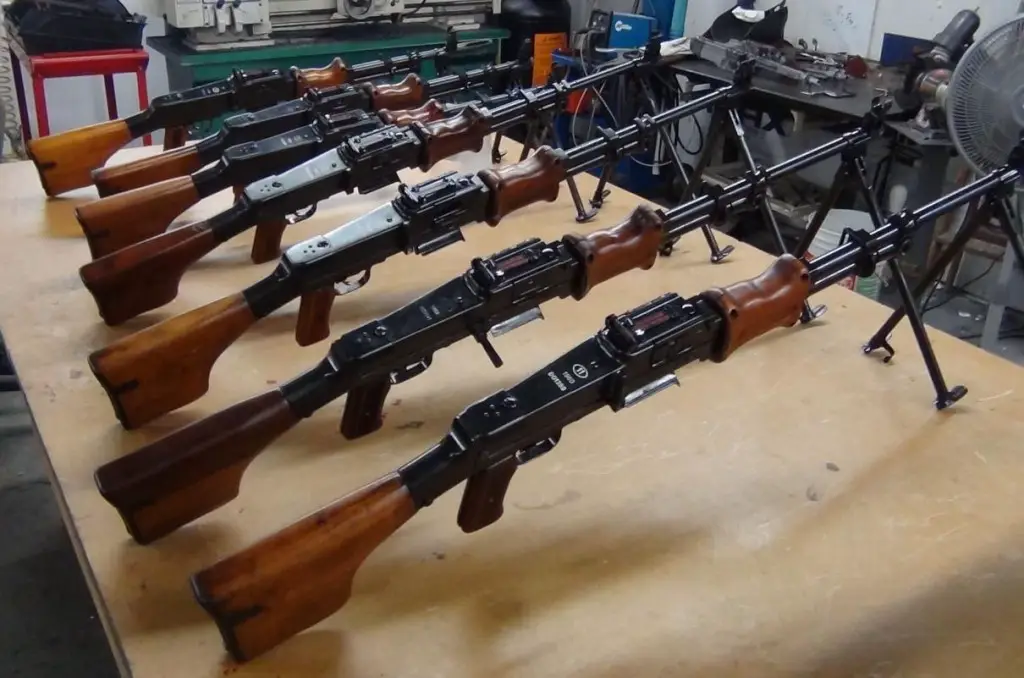
These Project Guns RPDs are shown on the website, but have already shipped to their new owners. They’re all made on Polish surplus RPD kits — while the metal is in great condition, the wood varies from “new” to “pretty beat up.”
Along with Russian production, RPDs were made in China and several satellite countries. The quality of manufacture varies from nation to nation.
In recent years, there have been numerous attempts to build RPDs from demilled kits into working semi-autos. The best known is probably the Wiselite build, but there are several small shops out there, and DSA is currently shipping RPD semis.
Stan Szalkowski of Project Guns took time out of his production day — the company comprises Stan and a guy who’s his helper and understudy — to show us how he did it. When he invited us in he was test-fitting parts in one of a batch of guns nearing completion.
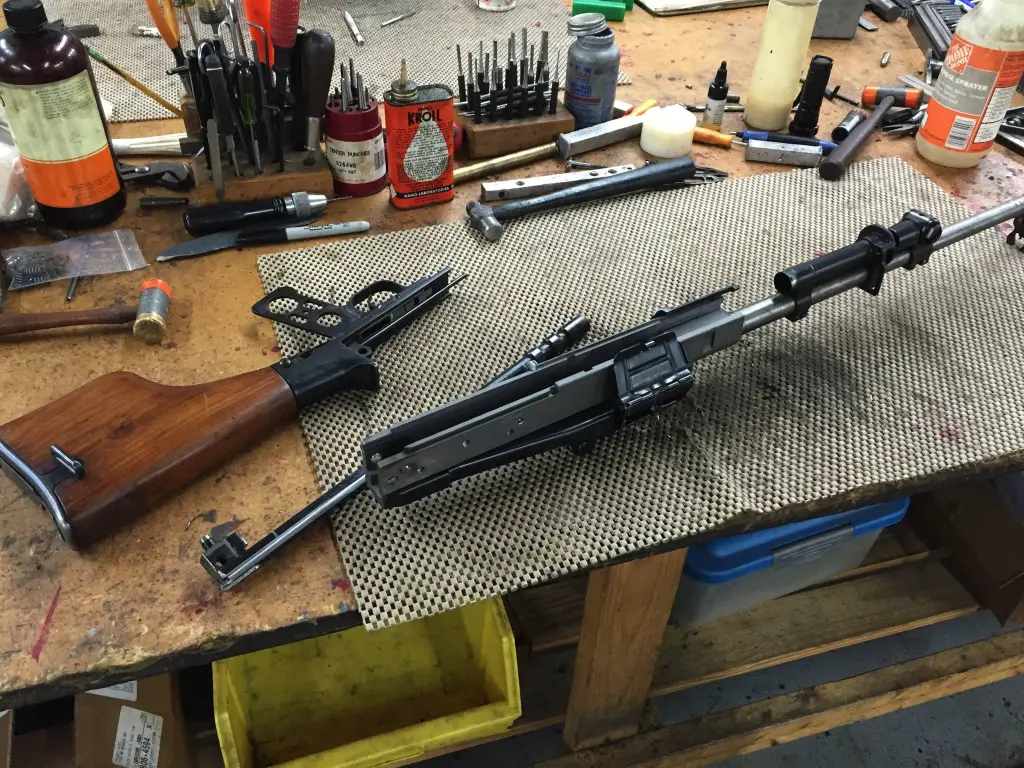
A semi-auto RPD approaches completion with careful hand-fitting on the gunsmith’s bench. When it works and passes test-fire, it’ll be blued, packed, and shipped to its proud new owner’s FFL.
The shop is neatly organized into three parts in an industrial zone of many small businesses. The main shop includes the desk Stan’s seldom at unless he’s on the phone to a customer or subcontractor, or designing a part or fixture in CAD (of which more later); the production benches and machinery, including manual lathes and mills, a Tormach CNC, presses, and of course, the gunsmith’s standard standbys: stones and files. Attached to the main shop is the stockroom, where the remainder of 150 RPD kits recently delivered await attention and some completed firearms for foreign destinations await the necessary paperwork drill: approval by national authorities, customs clearance and so forth. (Project Guns has a manufacturer’s license — in fact, as you go in the door, all the required licenses are displayed on the wall in case officialdom ever comes looking). The third section of the company, which we didn’t personally see, is in a separate unit, and it is where the messy and noisy processes happen: test firing and hot blue. Each rifle is test fired for forty or fifty rounds into a bullet trap (and remediated if needed). The hot blue process is extremely time sensitive, if you want to avoid having the whole thing flash to rust; so the separate shops encourage concentration on the job at hand. There are assembly days and bluing days.
To rebuild an RPD, Project Guns uses their own receiver design, milled from solid 4130 steel for them by a large Florida machine shop. Stan bead-blasts the receivers, then fits the parts to them, test fires them and disassembled them for rebluing. Apart from the US-made barrels and receivers (and many small parts), each RPD is assembled with parts that came from a single demilled RPD. Each kit came from Poland individually boxed and serial numbered, and the boxes are used to keep each set of parts together along its course of modification and assembly.
While the cut receiver parts from the original guns can’t be reused (Stan has been down the path of receiver rebuilds before, but with hundreds of RPDs under his belt, having a custom receiver is much easier), the front sight, bipod and gas system must be removed from the stubs of the demilled barrel. The barrel stubs are also scrap.
The design of the receiver is modified so that full-automatic parts don’t fit. Neither the internals nor an unmodified trigger group housing from a full-auto RPD can go on to a Project Guns receiver. This is required for ATF compliance. The Tormach CNC comes in handy making the required cuts to modify the trigger group housing, operating rod/slide and other internals, as we’ll see when we talk about CAD below.
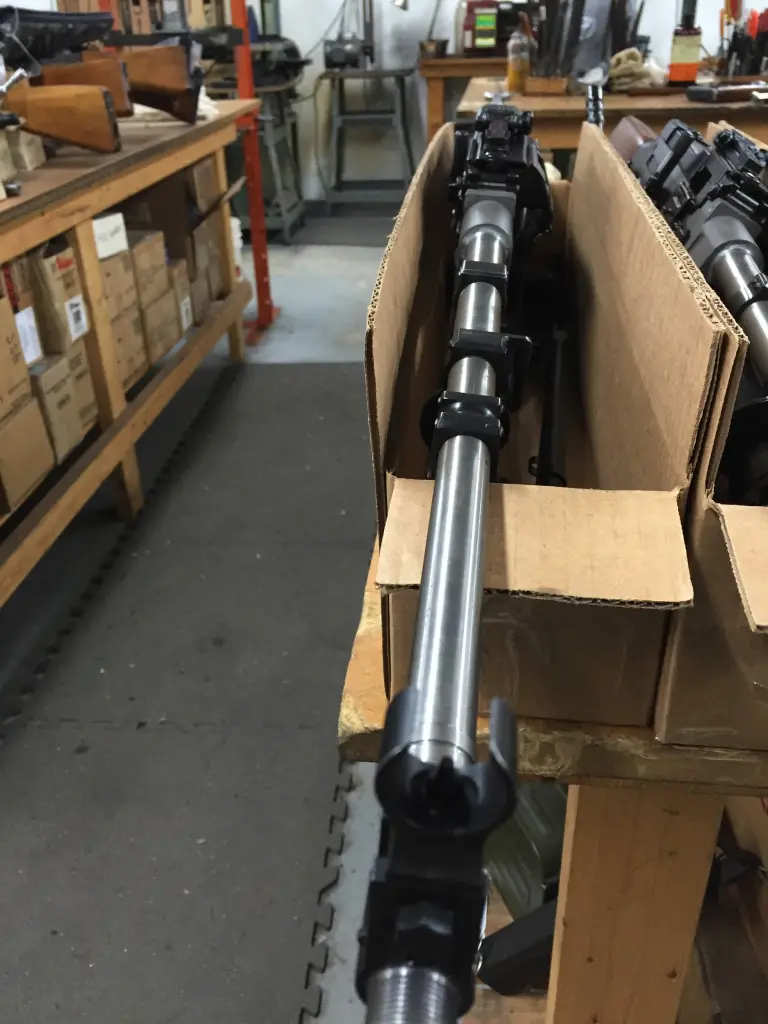
Here’s one of the US-made barrels installed in an RPD. If you peek over to the left, you see a batch of customer guns — Czech UK Vz.59s — in for troubleshooting.
The barrels are a story in themselves. The new barrels are US-made compliance parts, but they’re made for Project Guns by a major barrel maker: they’re chrome-lined like the originals. One problem with RPDs has been sight, barrel and gas system alignment. Some satellite nation guns, and some US semi builds, have been constructed with canted parts, which in a sight is inimical to accuracy, and in a gas system can be damaging to function. Stan has designed and built not only a special tool that ensures the perfect alignment of the parts, but also a specialty press for barrel installation that works with the tool.
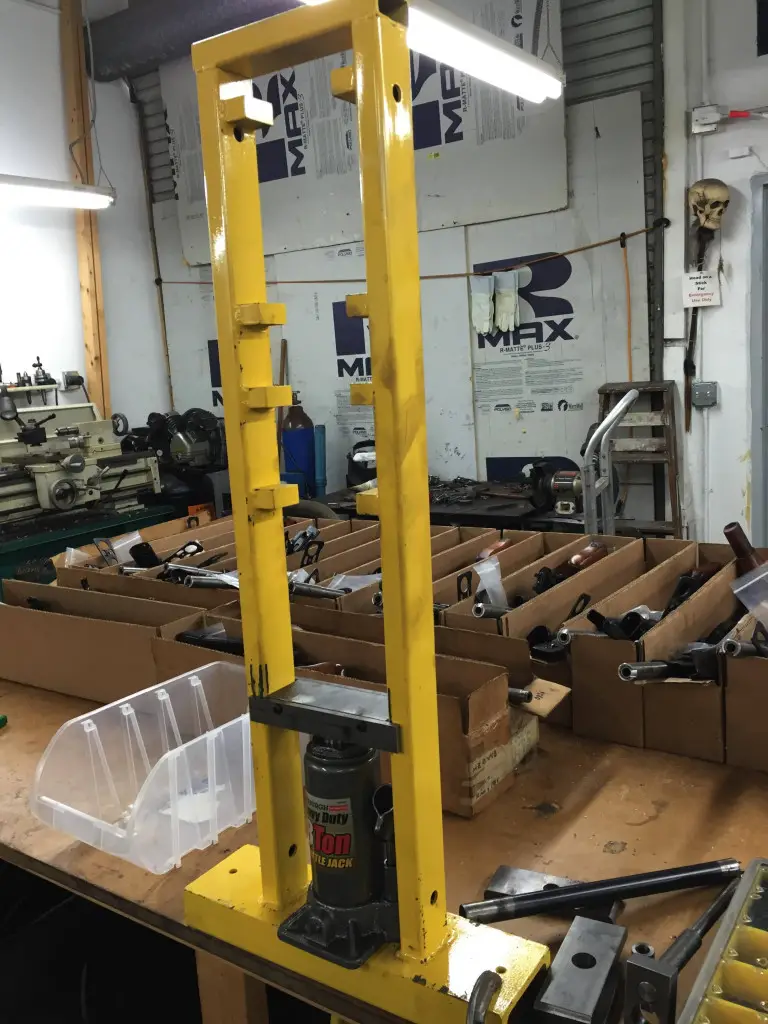
Scratch-Built Custom Barrel Press. Visible immediately to the left of the parts sorter on the right is the RPD barrel, sight and gas system alignment tool.
(He also uses a press that started off as a factory Harbor Freight press, but that he has extensively rebuilt, trued, and reinforced so that it actually works).
He showed us how he makes a custom tool, like the barrel/sight/gas system alignment tool, once he has it visualized in its component parts. (There are three parts to the tool: a base with a hole for the barrel and one for the mandrel, a mandrel that holds parts in alignment, and an insert that notches into the ejector cut in the barrel to ensure that everything’s directionally oriented and aligned properly). He envisions the part, and then sketches it in CAD. The program he uses is not something ridiculously expensive like CATIA, or something cutting-edge like SpaceClaim (which is a relatively reasonable $5000 or so). Instead, he used a combination of free and inexpensive PC software that meets his needs perfectly.
Initial design is done in the free application that’s downloadable from E-Machine-Shop. It also allows you to put your part out to bid. Stan has found that doing that, rather that working with shops he’s got experience with, can produce parts with so-so tolerances. But while the E-Machine Shop tool can produce a 3D file, it’s simply a drawing or representation — it’s not machine-ready.
For that, he uses Vectric’s VCarve Pro ($699 direct). We’re familiar with Vectric’s software (which is made in a confusing variety of versions, but they will help you find the right one for your application) for 2D cutting applications like laser cutting or CNC routing, but Stan uses it to generate tool paths. It accepts input for specific machine, for tool type (i.e. four flute end mill), size and, of course, feeds and speeds. Stan does these from experience, but a beginner can use feeds and speeds from Machinery’s Handbook and come out alright. In VCarve Pro, one can visualize the tool path in a simulation and correct it all on the screen before committing to metal. When the part looks like it’s being cut properly in the simulation, Stan saves the file to a thumb drive, and carries it a few feet to the Tormach.
The Tormach also comes in handy for the repetitive work involved in, for instance, modifying the trigger group housings. It repeats so well that if you design a fixture that doesn’t move when you remove and replace a part, you can set up the fixture and indicate in the first part, and then just run the Tormach and replace the parts without touching the indicator again.
Apart from parts modification, the in-house CNC is used mostly to make prototype parts and production tooling. Stan has a long-established relationship with production shops that make parts in mass quantities. These include semi-auto internals like linear hammers, small pins and dowels, muzzle nuts, and anything that’s unsat or not reusable in the basic kits.
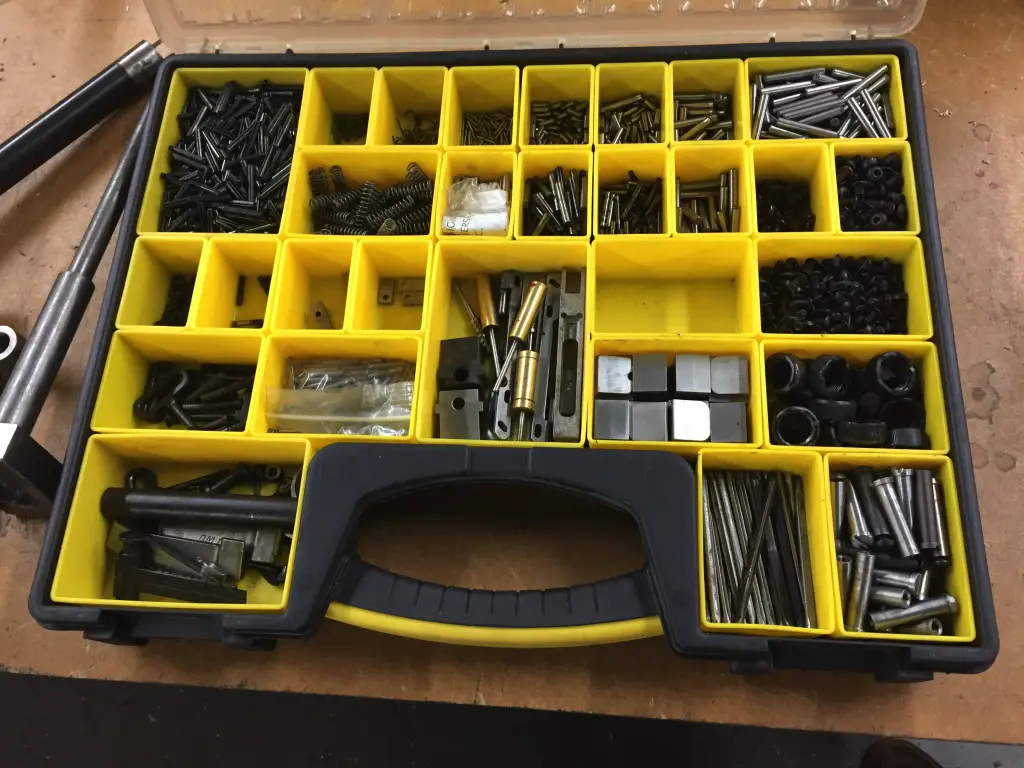
Project Guns’ small parts come from US short-run machine shops. After inspection, they go in this parts sorter for the assembly gunsmith.
Stan has built and shipped 450 RPDs in the past, and notes that the quality of this batch of kits shows that they’re more well-used than the early batches, which were guns that had been stored new and never fired until they were demilled. With a new receiver and barrel, and many new small parts, and new bluing, the metal parts will look new, but some of the wood in this shipment shows that some of these guns were used hard by the Polish Army during its Warsaw Pact days. You can probably make a request for a more pristine or a more “characterful” RPD at this point, but there’s no assurance there’s any more kits to be had after these, and as they get used up your choices may dwindle.
Of the 150 kits he’s building, 100 are earmarked for United States customers and 50 are spoken for by a Canadian distributor, assuming the Canadian can get clearance from the Mounties, something he’s been working on for some time already. It’s pretty hard to imagine a collector firearm like this, essentially an expensive toy, finding a criminal use, but the mere look of it casts an icy blast of terror on hoplophobes.
Project Guns is not a retail gun dealer. If you want to get your name on the list for an RPD — they’re $2,500 a pop — it’s time now, and the gun will be delivered to your local FFL.

Kevin was a former Special Forces weapons man (MOS 18B, before the 18 series, 11B with Skill Qualification Indicator of S). His focus was on weapons: their history, effects and employment. He started WeaponsMan.com in 2011 and operated it until he passed away in 2017. His work is being preserved here at the request of his family.

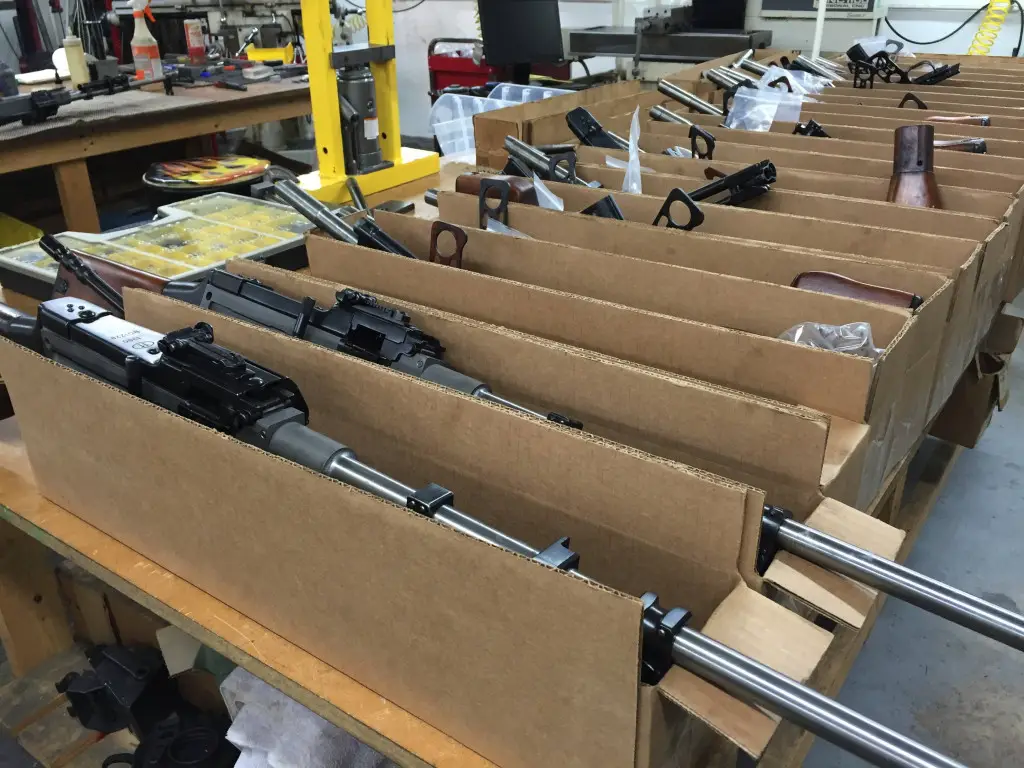
7 thoughts on “Where RPDs are Reborn as Semis”
Czech spelling? Looks Polish…
Hope you and yours had a safe and rewarding TT. Your secretary dropped the end of the sentence in the third last paragraph:
“You can probably make a request for a more pristine or a more “characterful” RPD at this point, but there’s no assurance there’s any more kits to be had after these, and as th.”
Now I wonder if this semi only RPD would take kindly to that bumpfire stock thingy you featured a while back…..
Corrected. I also corrected the spelling of Stan’s last name. (Sorry, Stan).
And for the bumpfire stock, adapting it to an RPD would be difficult. The RPD stock contains the recoil spring and ancillary parts.
OMG wall of text. I’ll read this, certainly. But this is day after turkey sit around and do nothing day.
Looks like a great gun, and no doubt way out of my price range.
🙂
It’s at the end of the post, but $2,500.
There is a free version of Spaceclaim… Called DesignSpark Mechanical.
The free version is stripped of keyshot rendering, sheet metal unfolding, iges and solid export, layouts, and motion simulations.
However it works fine for 3d printing, and it can export to Sketchup and use the low cost Sketchup layout to do layouts.
It also exports in 2D dxf. So if you got the Skillz to manually unfold something and then export it, it will still work. Although calculating bend radiuses and unfolding sheet metal curved pipes, are beyond my skills without specialized software.
What a damn pity the RPD never had a quick-change barrel. Or the RPK, so far as that goes….